This Split Travel Guide will teach you the best time to visit and why. We also share the best things to see and do in the city, places to stay, eat, and drink, and all necessary travel information to help you plan your stay in Split, Croatia.

©placesofjuma.com
Our website includes affiliate links. So, keep in mind that we may receive commissions when you click our links and make purchases. Please read our legal disclaimer document for more information about our Affiliate disclaimer and other disclaimers like Fair-Use disclaimer, etc.
Split Travel Guide: Overview
Split is the largest town in Dalmatia and the second-largest in Croatia (after Zagreb). It is an ideal Mediterranean city with a small-town vibe, lively streets, and easy-going locals.
From a stopover place for tourists catching a ferry to nearby islands or a bus to another, more exciting tourist destination, Split has become one of Croatia’s most popular spots. Furthermore, in the middle of the Dalmatian Coast, Split makes an excellent base for your Croatia tour. It is also an important transport hub and a port city.
Things to do in Split
First, this Split Travel Guide will show you some fantastic places and activities you can do while on your vacation there. Namely, the city has a lot to offer travelers. For instance, Diocletian’s Palace, a UNESCO World Heritage Site, is the town’s beating heart with its bars, restaurants, shops, traditional music, etc. Klis Fortress will appeal to history buffs and Game of Thrones fans (featured in the fourth season). Besides its coastal location, Split is a starting point for some of Croatia’s most beautiful islands, including Hvar.
Split Travel Guide: The Peristil of Diocletian’s Palace

©itinari.com
Explore the old town.
Split’s Old Town is home to Diocletian’s Palace. This pedestrian-friendly area is a medieval paradise with cobblestone streets, trendy restaurants, bars, shops, and hotels. Moreover, while walking, you can visit Nadalina for gourmet chocolates, Croatia for silk cravats, and Ribarnica, the fish market. If you have accommodations with a kitchenette, you can buy fresh fish and cook it yourself. You’ll find signs throughout Old Town guiding you to businesses and attractions. However, asking your hotel concierge for a map is recommended because it’s a maze of alleyways.
Wander freely in the Ancient Palace.
Did you know Split’s Old Town is home to Diocletian’s Palace? This palace complex, built in the fourth century for Roman emperor Diocletian, is one of the world’s earliest designated UNESCO World Heritage Sites. Although the palace declined after Diocletian’s death, it is still with us today. It forms a large part of Split’s historic center. This area is a pedestrian-friendly medieval paradise with cobblestone streets, trendy restaurants, bars, shops, and hotels. You can even buy fresh fish at Ribarnica, the fish market, if you have a kitchenette in your accommodations. If you plan to explore Old Town, asking your hotel concierge for a map is recommended, as it can be a maze of alleyways.
Note: You can book a super guided tour around the city’s old town here.
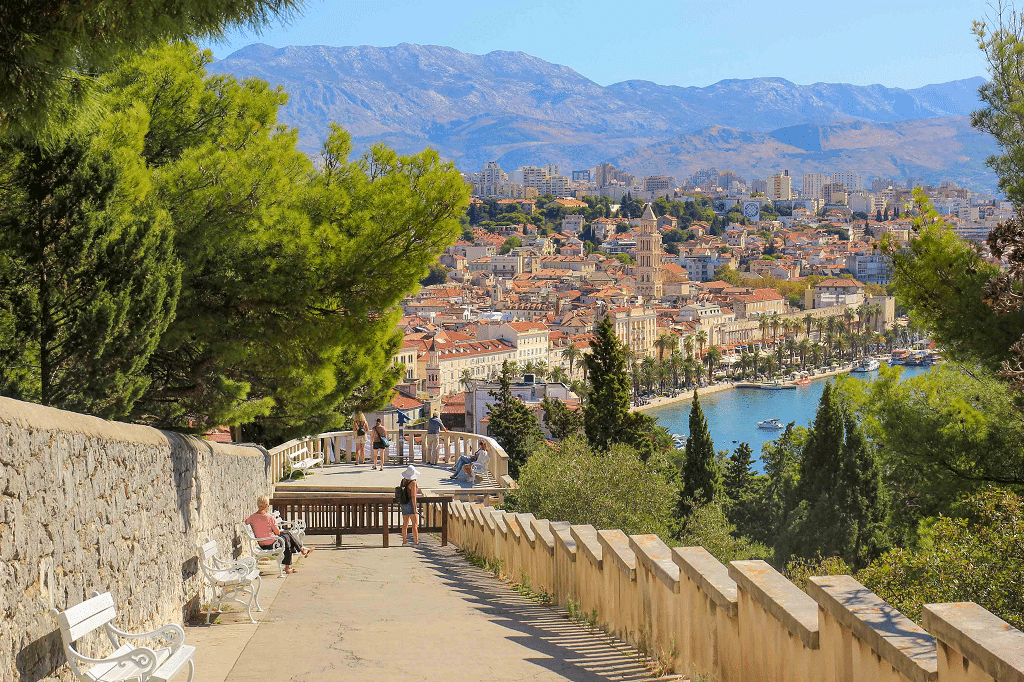
©placesofjuma.com
Viewing the terrace on the Marjan Peninsula
Locals recommend Marjan Park for sunset views in Split. A popular spot is a 15-minute walk (through the charming park) from the center near the cathedral, but it’s a bit far from the old town and not directly facing the sunset.
Split Travel Guide: One of the most famous local dishes is Pasticada.
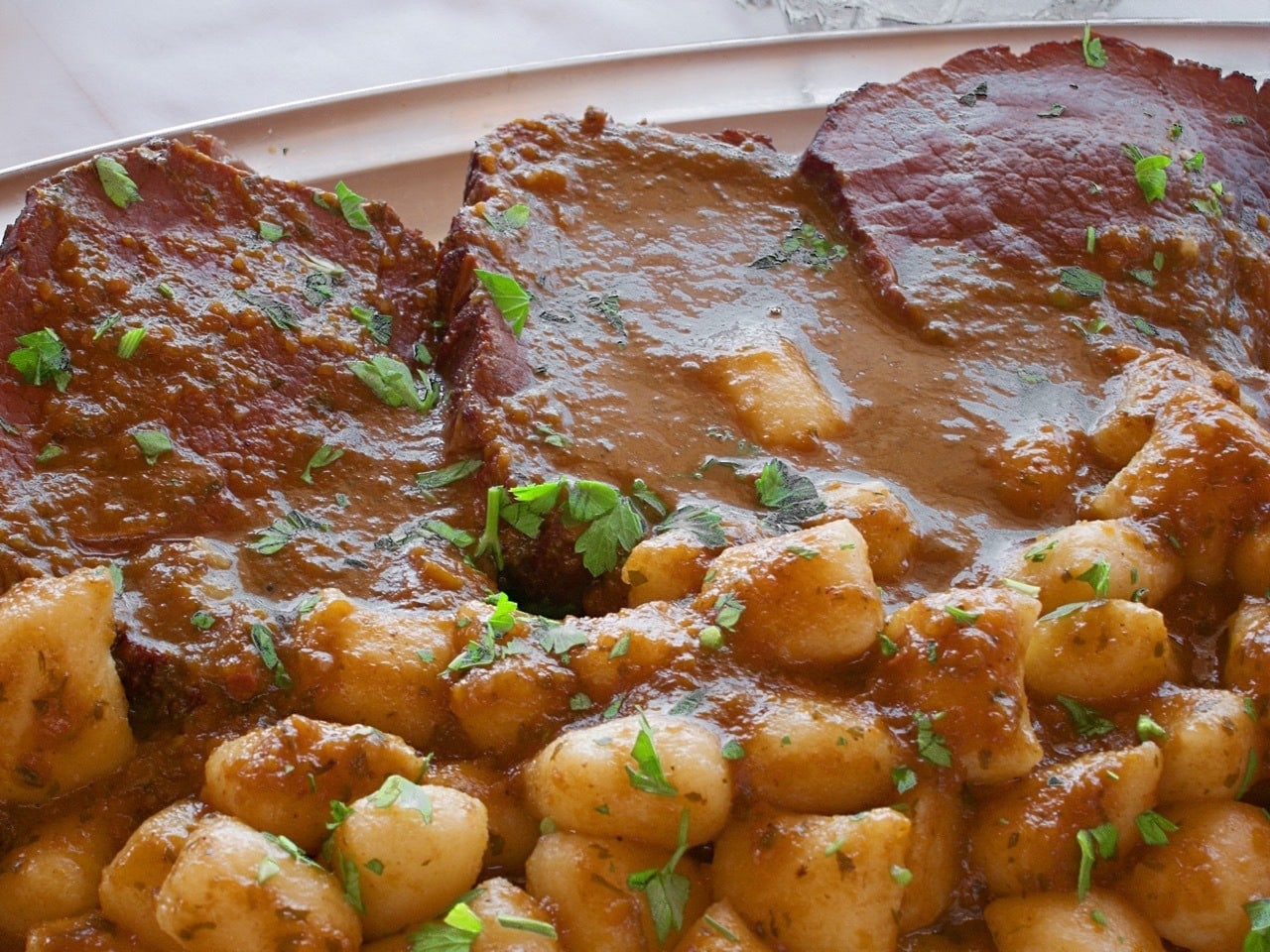
©chasingthedonkey.com
Try local food
When visiting Split, Croatia, you’ll find a delightful culinary scene that combines traditional Dalmatian flavors with Mediterranean influences. Here are some dishes you should try in Split and why they are worth experiencing in this vibrant city. Ultimately, you could drink local wine with it or try local liqueurs like rakija or travarica.
- Pasticada – his dish features slow-cooked beef in a sauce made with onions, nutmeg, prunes, and prošek – a sweet dessert wine made with Croatian grape varieties.
- Dalmatian Prosciutto—This salty dry-cured ham is a popular starter dish in Split and throughout the country. Locals typically eat prosciutto on a platter that includes a variety of local cheeses, olives, small stuffed peppers, and pickles.
- Brudet is one of the true classics of traditional Croatian cuisine, prepared with various seafood. Finding a unique brudet recipe is nearly impossible since every region, town, and household has its favorite version.
- Black Risotto—This intriguing dish gets its black color from squid or cuttlefish ink, which aromatizes it with its signature salty flavor.
- Mandulat – Mandulat or bademovac is a traditional dessert from Dalmatia, similar to Italian torrone and Turkish halva.
An Example of the popular Klapa music – Ne diraj moju ljubav (Don’t touch my love).
Go and listen to some traditional music.
Klapa music is a traditional capella singing style that originated in Dalmatia. It is usually performed by a group of four to eight singers, with five or six being the most common number. The singers are typically men, with a first tenor and several tenors, baritone, and bass voices. Klapa’s songs often center around themes of love, loss, nature, home, yearning, and the Mediterranean way of life. A mandoline or guitar frequently accompanies them. Suppose you find yourself wandering the limestone streets of Split. In that case, it’s common to hear the beautiful and harmonious sounds of Klapa music coming from near Peristil Square before the Split Cathedral.
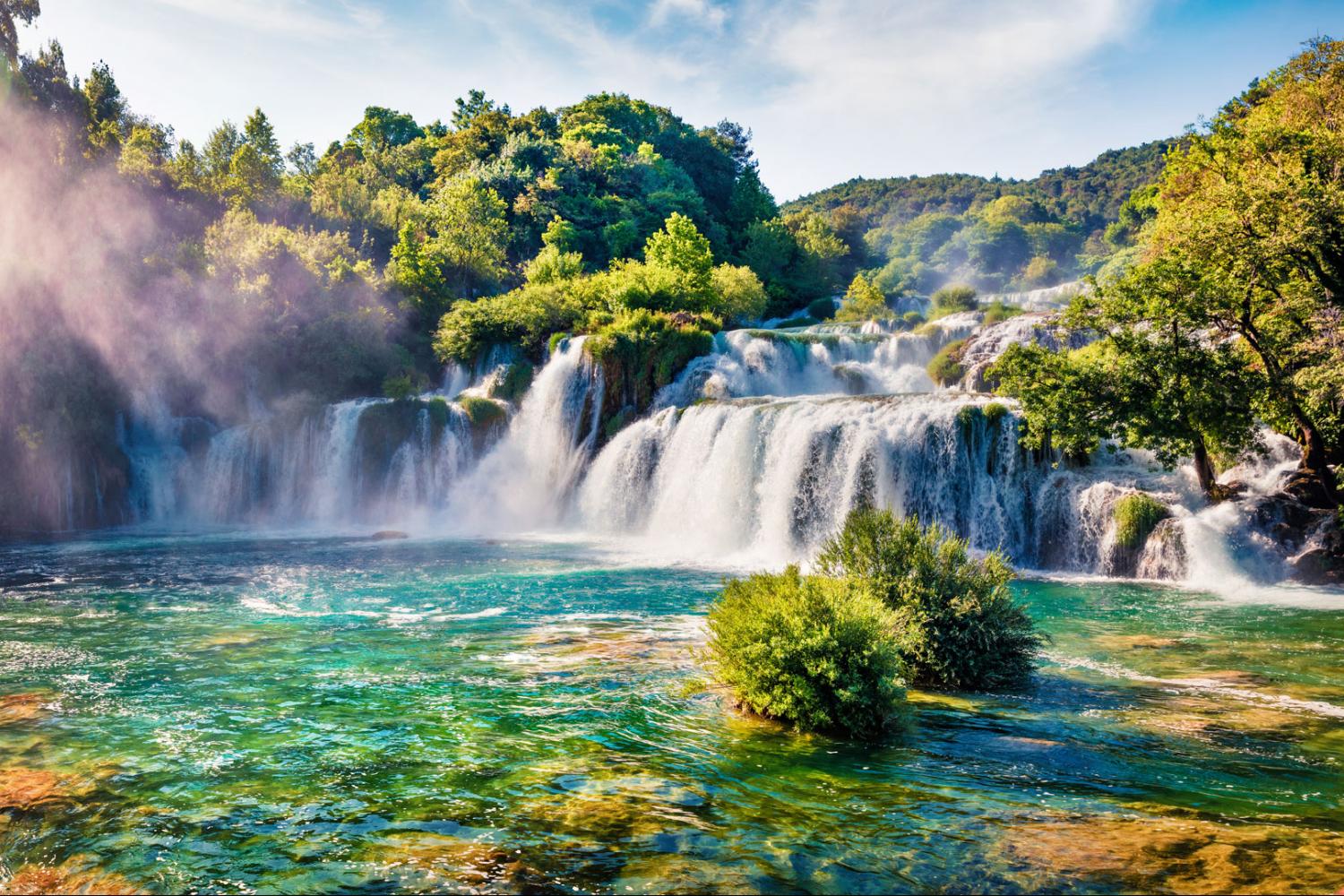
©grayline.com
One-day trips from Split
Once you are there, don’t hesitate to visit some other nearby sites. You will find some splendid beaches near the city, such as in Makarska Riviera, notable little towns (such as Primošten), islands, and much more. You can even visit jewels like Dubrovnik or Mostar. However, there’s so much to see, so we focused only on the most essential ones.
Krka National Park
If you’re traveling in Croatia, you should visit Krka National Park. The park is on the Krka River and has gorgeous waterfalls and gorges. The river flows through a deep canyon that is over 200 meters deep. One of the main attractions is a one-hour walk across boardwalks that connect islands in the emerald-green river. Ultimately, this walk ends at the park’s biggest waterfall, Skradinski Buk, which is truly stunning. Take the chance to enjoy the natural beauty of Krka National Park on your next visit to Croatia. You can also book a great tour by clicking here.
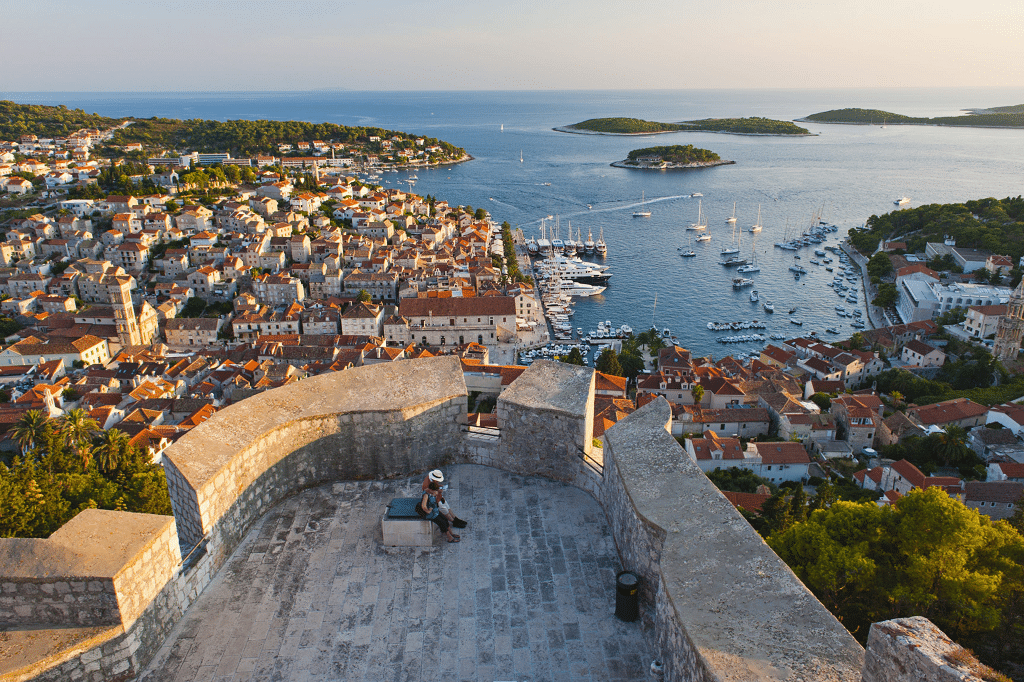
©Robert Hardy Imagery/Getty Images
Lavish Hvar
With historic architecture, gorgeous swimming spots, and lively nightlife, the beautiful island of Hvar is one of Croatia’s most popular destinations in its own right. Though it’s worth staying here at least a night or two if you can, it’s also possible to visit Hvar as a day trip from Split – you’ll want to get the fast catamaran direct to Hvar Town, the island’s largest and most charming settlement. You can book your preferred tour of this island by clicking on the following link.

©camping-simuni.hr
Take a day trip to Trogir.
Trogir is an excellent option if you’re looking for a convenient day trip from Split. This small town, located 32 kilometers north of Split, is filled with medieval churches and surrounded by beautiful white limestone walls. One of the highlights of Trogir is the Cathedral of St. Lawrence, which began construction in the late 12th century. Visitors not afraid of heights can climb up the tall, 15th-century bell tower for a great view. And the best part? You won’t have to battle crowds of cruise ship tourists to explore this charming town. Catch one of the frequent buses to Trogir from Split’s central station.
Note: If you’d like to book a guided tour, click here.
How to get to Split?
Split is effortless to reach as it is the second-largest travel hub in Croatia after Zagreb. You can reach Split by plane, car, train, bus, or ferry. The Split bus station, train station, and ferry port are all close to each other and within walking distance of the old town. However, Split Airport Resnik (SPU) is 20 km northwest of downtown Split, near Trogir.
By Plane
If you travel by plane, a shuttle service between Split Airport and downtown is available. Shuttle buses depart 20 minutes after landing, and it takes 30 minutes to reach Split downtown. Alternatively, you can take a taxi, but it is more expensive. The cheapest way to get to Split from the airport (and vice versa) is to bring local bus no. 37 or no. 38, as both lines have a scheduled stop near the airport. Another option is to fly into Zadar airport, which is only 150 km northwest of Split and has some cheap Ryanair flights.
Trains and Buses
If you prefer to travel by train, you can take a train from Zagreb to Split. Trains run thrice a day from June 15 until September 15 and once daily for the rest of the year. The train ride takes six hours, and you can find more information on the Croatian Railroads website.
For those traveling by bus, intercity buses connect Split with Zagreb and many coastal towns. They run frequently throughout the day and year-round. It takes five hours to reach Split from Zagreb, and you can find affordable deals by checking Omio’s website.
By Ferry Split is an essential port for the central Dalmatian island if you plan to travel by ferrys. It provides local ferries and direct connections to Ancona, Italy. Jadrolinija, the largest ferry operator in Croatia, offers ferry schedules and prices on its website for easy ticket booking, including the Split-Ancona route that operates once a year.
A helpful tip for those traveling by ferry: During high season, ferries tend to get crowded, so it’s best to arrive at least two hours before departure, especially if you travel by car.
With a car
Finally, if you travel to Split by car, it is easy to reach from many places in Croatia. If you are coming from Rijeka or Zagreb, you can take motorway A6/A1, which takes about four hours to reach Split from either city. Alternatively, you can take the old D1 road to save on tolls, but remember that it goes through villages and is a single-carriageway road.
Notifications:
- Click here if you want valuable trains, buses, and shuttle deals.
- If you’d like to get valuable deals for flights to Split, click here.
- But if you are traveling by ferry, click here.
Getting Around Split
Renting a car is the best option to travel around Split with maximum flexibility. However, relying on the city’s buses is more economical if you want to save money. Walking is also a great option to stay close to Old Town. To travel to nearby Croatian islands, you can catch a boat from Trajektna Luka Split, about a 10-minute walk from Old Town.
How many days should I plan for Split?
All the sights in the center of Split are within walking distance. You could rush by the main highlights if you are on your feet for the whole day. However, we still recommend a slower tempo, so enjoy the city’s vibe.
We recommend you stay two to three nights in Split. Then you still have enough room to take a relaxing stroll while visiting the classic sights, and maybe even for a trip to the beach.
If you also want to take some day trips (such as to Trogir or Krka National Park), we plan to stay a little longer. Four to five nights would be ideal. We promise you will not get bored in Split—there is much to see and experience.
The best time to visit Split
Although Split is great to visit year-round, the best time to visit Split is from May through October. However, June and September are better times than July and August because the weather in July and August is scorching, and the crowds of tourists are everywhere.
June and September are good months to visit Split, but we prefer a bit more because the sea is warmer in September than in June.
So, the best time to visit Split is the second half of September, when the weather is still warm, dry, and sunny but not hot. The sea temperatures are still high enough for swimming. School holidays are over by mid-September, and there are fewer tourists in Split and elsewhere in Croatia.
Fortress Klis
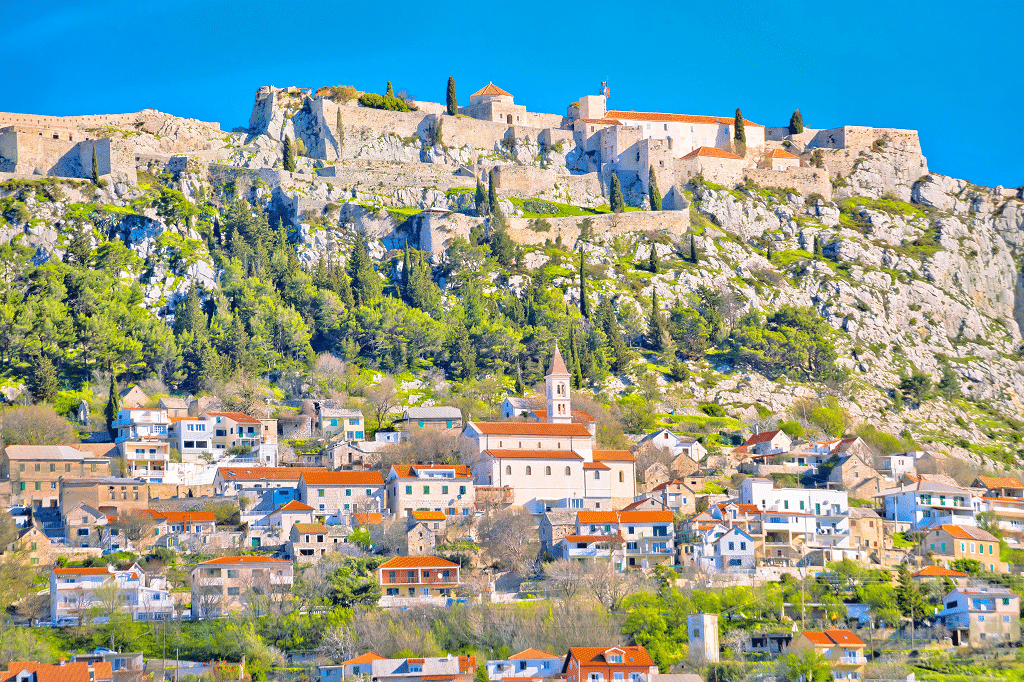
©trip.com
Where to stay in Split?
Split Old Town is the best area to stay in because you will be in the heart of everything and close to the action. The old town is a great place for first-time visitors to stay in Split.
Here, you will find various accommodation options, from cozy B&B to lovely heritage boutique hotels, all housed in historic buildings with character.
Note: The old town is car-free; you must park outside the palace walls if you travel by car. Hotels usually have a porter service to help you with the luggage, but not Airbnb.
Note: Click here to get some valuable deals.
Safety
Croatia is a safe place for solo travelers, especially women. Crime rates are low, but petty theft can still happen in crowded tourist areas. Keep your valuables hidden, and don’t leave them unattended at the beach. Be aware of your surroundings at night and watch your drink to avoid spiking. Check out solo female travel blogs for more tips.
While scams here are rare, you can read about common travel scams to avoid here.
Split travel guide: Useful tips
- Book an apartment over a hotel
- Decide where to stay: in the old town center or slightly out of town along the coastline.
- Get the SplitCard and free entry to museums (or a significant discount) when you present your SplitCard.
- Travel during shoulder season
- Walk everywhere: Split may be Croatia’s second-largest city, but it’s small.
The Conclusion of the Split Travel Gide
Split Travel Guide has covered some basic things about this fantastic coastal city that attracts millions of tourists annually. However, we are aware that that is only some of it. So, if you have any other ideas about what to see, do, or where to stay, you are welcome to share your opinions with us in the comments below.
Take a look at
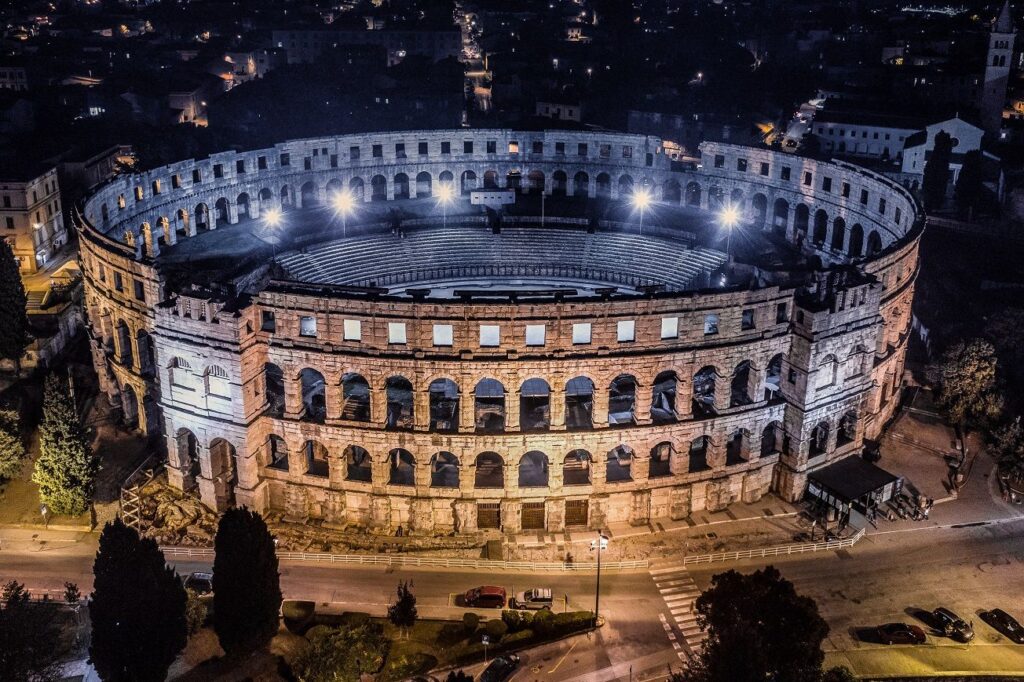
Visit Istria
Visit Istria guide will introduce you to this magnificent Croatian peninsula. Furthermore, you will find out why you should visit

Primosten – The cutest little town
Primosten—the cutest little town on the Adriatic coast—is undoubtedly one of Croatia’s top hidden gems waiting to be discovered. Its

Ultimate travel guide to Rovinj
In this Ultimate travel guide to charming Rovinj, we will introduce this magnificent little town in the peninsula of Istria
Photo credits:
Feature Photo Credits: wanderlustchloe.com
